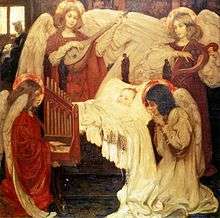Isobel Lilian Gloag
Isobel Lilian Gloag (1865–1917) was an English painter, known for her oil and watercolour portraits, as well as posters and stained-glass designs.[2][3]
Isobel Lilian Gloag | |
|---|---|
| Born | 1 August 1865[1] London |
| Died | 5 January 1917 (aged 51) London |
| Nationality | British |
| Known for | Painting |
Biography
Gloag was born in London, the daughter of Scottish parents from Perthshire.[4] Her early studies were made at St. John's Wood Art School, and she later studied at the Slade School of Fine Art. Ill health compelled her to put aside plans for regular study, and she entered the studio of M.W. Ridley's for private instruction, following this with work at the South Kensington Museum. After still further study with Raphaël Collin in Paris, she returned to London and soon had her work accepted at the Royal Academy of Arts, where she exhibited a total of 19 works.[5][2] She was an elected member of the Royal Institute of Oil Painters and the New Society of Painters in Water-Colours.[3] Her earlier works were inspired by the Pre-Raphaelites, while later works were more modern,[3] and her works have been cited as examples of post-Victorian Aestheticism.[6] She made several designs for the stained-glass artist Mary Lowndes. Suffering from health problems throughout her life, she died in London on 5 January 1917, aged 51.[1] Her work was posthumously featured in an exhibition at the Grafton Galleries, London.[7]
References
- "Benezit Dictionary of Artists". Benezit Dictionary of Artists. 2011. doi:10.1093/benz/9780199773787.article.B00075639. Retrieved 13 April 2018.
- Clement, Clara Erskine (1904). Women in the Fine Arts: From the Seventh Century B.C. to the Twentieth Century A.D. Houghton, Mifflin. p. 145.
- Gray, Sara (2009). "Gloag, Isabel Lilian". The Dictionary of British Women Artists. Casemate Publishers. pp. 118–119. ISBN 978-0-7188-3084-7.
- Greig, James (May 1902). "Isobel Lilian Gloag and her work". The Magazine of Art. Vol. 26. pp. 289–293.
- Wootton, Sarah (2008). ""Into her Dream he Melted": Women Artists Remodelling Keats". Romanticism and Victorianism on the Net (51): 0. doi:10.7202/019260ar.
- Nunn, Pamela Gerrish (2011). "Alienation, Adoption or Adaptation? Aestheticist Paintings by Women". Cahiers victoriens et édouardiens (74): 141–154. doi:10.4000/cve.1364.
- "London Letter". American Art News. 15 (32): 5. May 19, 1917. JSTOR 25589073.
Further reading
| Wikimedia Commons has media related to Isobel Lilian Gloag. |
- Reddie, Arthur (March 1916). "Paintings by Miss I. L. Gloag, R.O.I." The International Studio. 58: 32–38.
- Houfe, Simon (1996). The Dictionary of 19th Century British Book Illustrators and Caricaturists. Woodbridge: Antique Collector's Club. p. 154. ISBN 1851491937.


.jpg)